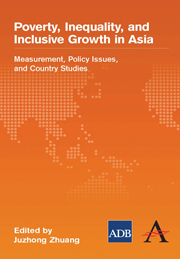Book contents
- Frontmatter
- Contents
- Foreword
- Preface and Acknowledgments
- Contributors
- Abbreviations, Acronyms, and Symbols
- Tables, Figures, and Boxes
- 1 Poverty, Inequality, and Inclusive Growth in Asia
- Part A Measuring Inequality and Poverty
- Part B Selected Policy Issues for Inclusive Growth
- 5 Inclusive Growth through Full Employment: The Role of Investment and Industrial Policy
- 6 Why is Access to Basic Services Not Inclusive?
- 7 Social Protection in Asia
- 8 Governance and Institutional Quality and the Links with Growth and Inequality: How Asia Fares
- Part C Country Studies
- Index
7 - Social Protection in Asia
from Part B - Selected Policy Issues for Inclusive Growth
Published online by Cambridge University Press: 05 March 2012
- Frontmatter
- Contents
- Foreword
- Preface and Acknowledgments
- Contributors
- Abbreviations, Acronyms, and Symbols
- Tables, Figures, and Boxes
- 1 Poverty, Inequality, and Inclusive Growth in Asia
- Part A Measuring Inequality and Poverty
- Part B Selected Policy Issues for Inclusive Growth
- 5 Inclusive Growth through Full Employment: The Role of Investment and Industrial Policy
- 6 Why is Access to Basic Services Not Inclusive?
- 7 Social Protection in Asia
- 8 Governance and Institutional Quality and the Links with Growth and Inequality: How Asia Fares
- Part C Country Studies
- Index
Summary
Introduction: The case for social protection in developing Asia
Broadly speaking, social protection refers to society's protection of its individual members from various lifetime risks. Some population groups, in particular the poor, are more vulnerable to such risks than others. Social protection usually takes the form of government programs such as labor market interventions, social insurance, and social safety nets. Among these, the modern cradle-tograve welfare state throughout developed countries firmly took root in the postwar era.
Until quite recently, conventional wisdom held that poorer countries could not afford social protection and that they should concentrate on achieving rapid economic growth. Such perception was shaped by the Washington Consensus that implied that poverty reduction naturally follows from growth (see, for example, Perry et al. 2006). The experiences of the East Asian miracle economies seemed to vindicate this line of thinking. Decades of uninterrupted economic growth lifted hundreds of millions out of poverty through trickle-down effects.
The devastating Asian financial crisis of 1997/1998, however, shattered the complacent notion that growth and growth alone guarantees poverty reduction, alerting regional governments to the importance of social protection. The economic impact of the crisis was severe and resulted in high unemployment and other social dislocations. In retrospect, a major silver lining of the Asian crisis was that, in its aftermath, governments across Asia began paying more attention and devoting more resources to social protection.
- Type
- Chapter
- Information
- Poverty, Inequality, and Inclusive Growth in AsiaMeasurement, Policy Issues, and Country Studies, pp. 228 - 267Publisher: Anthem PressPrint publication year: 2010



